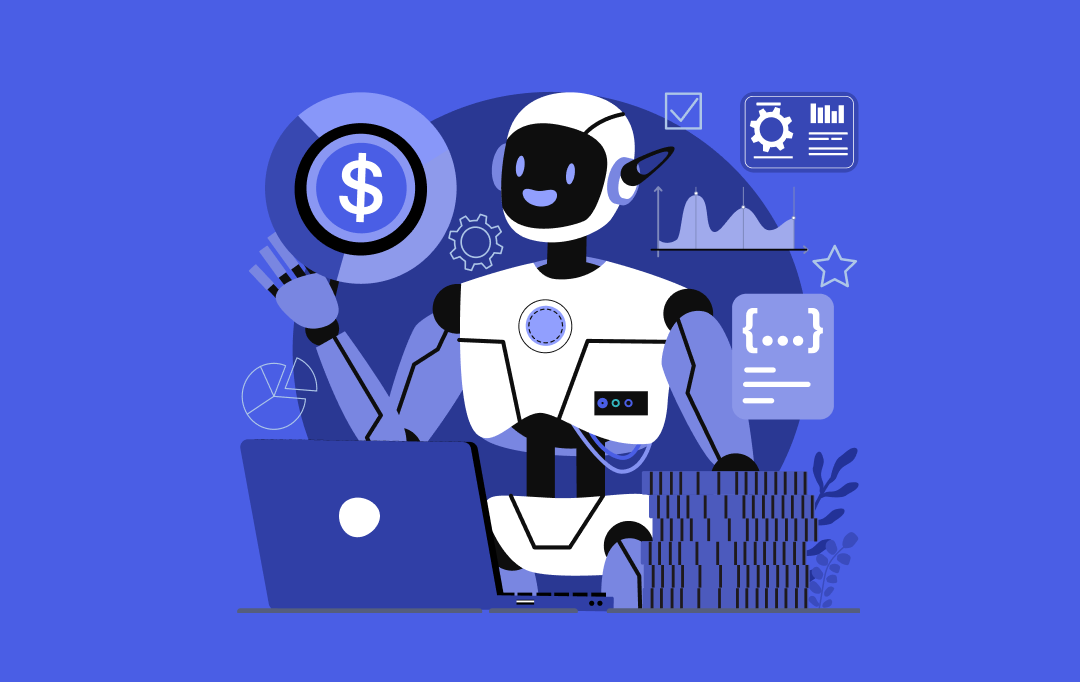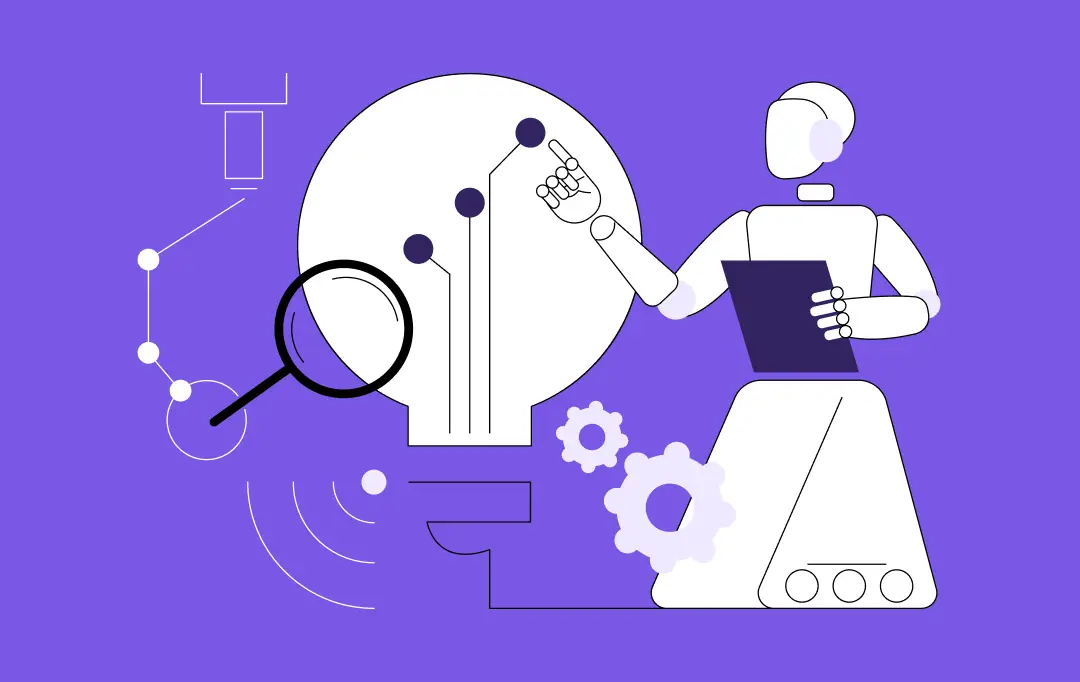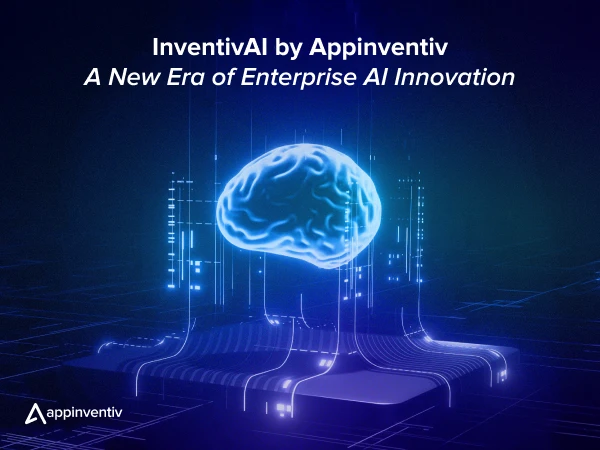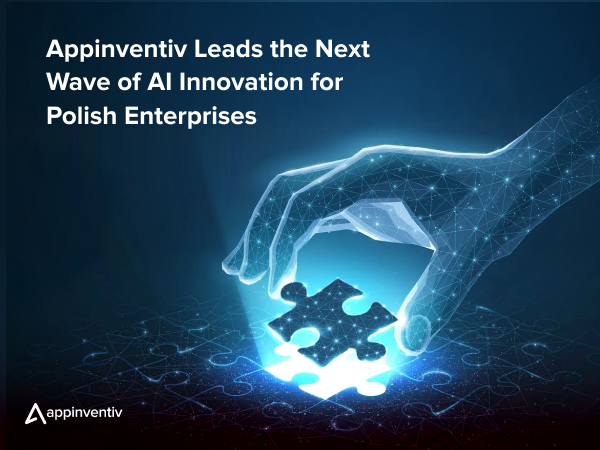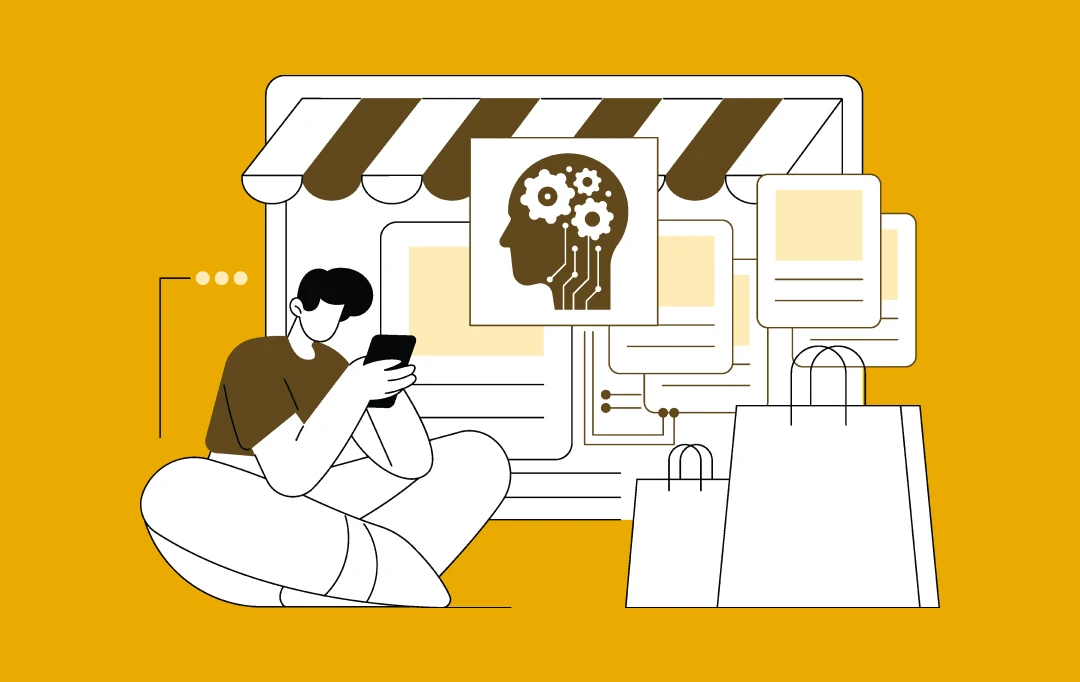- Why Generative AI in eCommerce Matters More Than Ever
- How Does Generative AI for eCommerce Marketing Work? It's All About the Models.
- Generative AI Applications in eCommerce and How It Is Transforming the Industry
- Hyper-Personalized Customer Experiences
- Automated Product Descriptions and Content Generation
- AI-Powered Visual Search
- Predictive Inventory and Supply Chain Optimization
- Intelligent Customer Support
- Immersive Shopping Experiences
- Hyper-Targeted Marketing Campaigns
- Product Design and Innovation
- Dynamic Pricing Optimization
- Scalable Customer Insights and Analytics
- How to Implement Generative AI Solutions in eCommerce Operations
- Cost of Implementing Generative AI in eCommerce
- Future of Generative AI in eCommerce
- What Makes Appinventiv Your Ideal Partner for Integrating Generative AI in eCommerce?
- FAQs
Key takeaways:
- Moving from experimental to essential for online businesses
- Companies like Amazon are seeing massive adoption with their AI tools
- Early adopters are gaining significant competitive advantages across operations
- Implementation costs are dropping while returns are increasing substantially
- The technology is transforming everything from customer service to inventory management
Do you remember your last online shopping experience? You probably spent way too much time scrolling through endless product pages, trying to find exactly what you wanted. Odds are optimum that you abandoned the cart without making the payment, as you didn’t find the best match for your exact needs or bought something that wasn’t quite perfect. Frustrating, right?
Now imagine this instead: You land on a website and instantly get personalized recommendations that feel like they were handpicked just for you. An AI assistant knows exactly what you are looking for, what will suit you, and even what your budget is—even when you can’t quite explain it yourself. The whole experience feels effortless.
This isn’t some distant future scenario. It’s happening right now, and generative AI in eCommerce is making it possible.
Companies aren’t just experimenting anymore—they’re going all-in. Amazon has over 900,000 sellers using their AI tools, and here’s the crazy part: sellers accept the AI-generated content with barely any edits about 90% of the time. That tells you everything about how good this technology has become for customers, companies, and sellers alike.
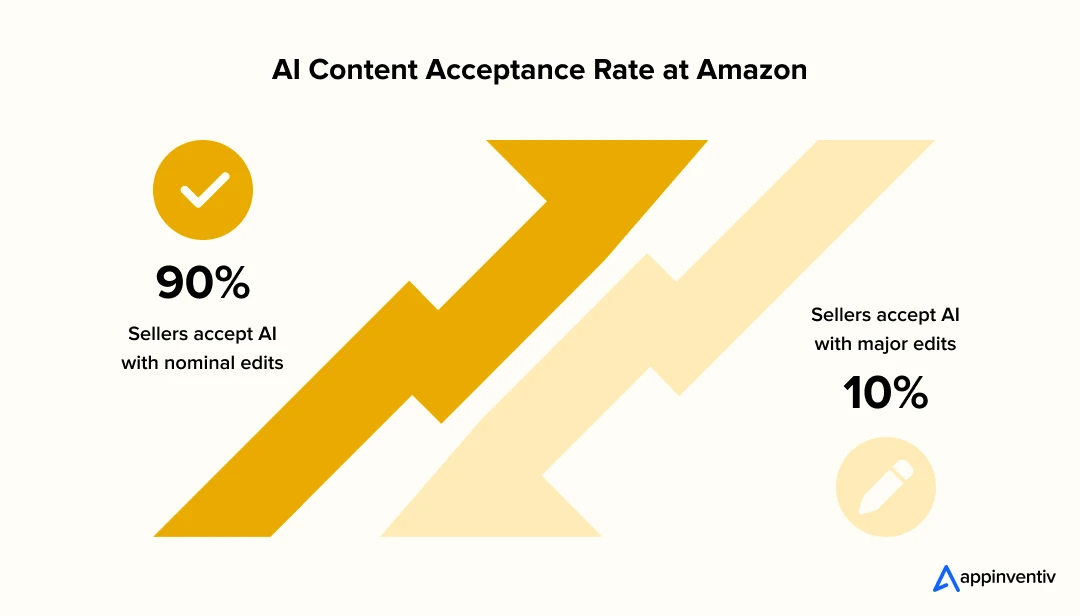
The transformation is real, and it’s accelerating fast. Businesses that win to jump on this now can walk with their shoulders high, and those who fail may vanish in recent years.
If you are still unsure about the life-saving applications of Gen AI in eCommerce, this blog is for you. Stay tuned with us to the end, and you will uncover some fascinating facts that will compel you to embrace the Gen AI trend at once.
Tap into this AI advantage for your business today!
Why Generative AI in eCommerce Matters More Than Ever
The eCommerce landscape has reached a tipping point. Traditional approaches to online retail are no longer enough to meet modern customer expectations. Shoppers demand personalization, instant responses, and seamless experiences across every touchpoint.
Generative AI eCommerce solutions are answering this call. According to McKinsey, companies investing in AI see a 3 to 15% increase in revenue and a 10 to 20% improvement in sales ROI. But the impact goes deeper than revenue numbers.
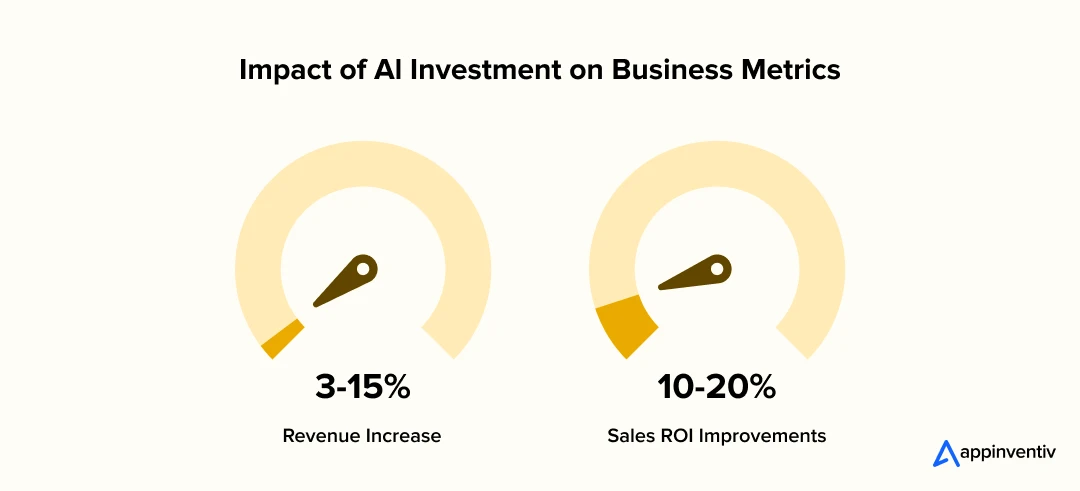
Consider the shift in customer behavior: 46% of Gen Z chose to begin searches through social media platforms instead of through Google, while 47% of Gen Z are using generative AI on a weekly basis. This generation expects AI-powered interactions as standard.
The competitive advantage is clear. B2B companies are leading the charge into generative AI, allocating a larger portion of their e-commerce budgets (11 to 25%) compared to B2C companies (Source: McKinsey). Early adopters aren’t just experimenting—they’re scaling AI across their entire operations.
Also Read: Using Generative AI for Business to Solve Complex Challenges
How Does Generative AI for eCommerce Marketing Work? It’s All About the Models.
At its core, generative AI for ecommerce businesses operates through sophisticated AI models trained on vast datasets. These models learn patterns, structures, and relationships within data, enabling them to generate new, original content. They are like a creative engine that can understand and produce human-like text, realistic images, new designs, and even intelligent conversations.
The primary types of models driving generative AI services in eCommerce include:
- Large Language Models (LLMs): LLMs like GPT-4 and Google’s Gemini are core for natural language generation (NLG) tasks. These LLMs understand and produce human-like text for everything from customer service interactions to marketing copy.
- Generative Adversarial Networks (GANs): These models consist of two neural networks, a generator and a discriminator. These models are perfect for creating realistic product images, elevating your visual content game, and even enabling immersive virtual try-ons for customers.
- Diffusion Models: These are powerful models for image and video generation. They create high-quality visual content by gradually refining random noise into coherent images.
Generative AI applications in eCommerce use these models to automate tasks, personalize interactions, and derive actionable insights from massive datasets.
Now that we know how Gen AI in eCommerce works, let’s shed light on its real-world applications and examples to have a better understanding of its potential in the industry.
Generative AI Applications in eCommerce and How It Is Transforming the Industry
Looking for some compelling applications of generative AI in eCommerce. Well, from AI-powered visual content creation to virtual try-ons, the use cases of Generative AI for eCommerce businesses are vast and far-reaching. Let’s take a deep dive to know how Gen AI can redefine the retail and eCommerce industry.
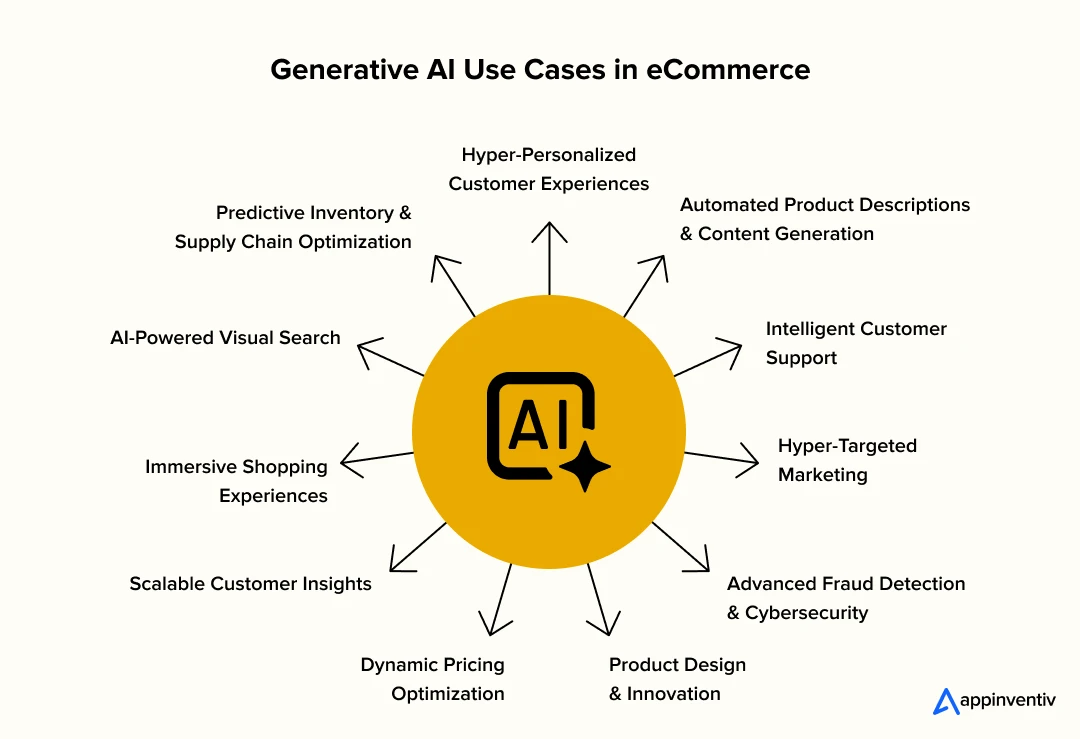
Hyper-Personalized Customer Experiences
Remember when “personalization” meant putting someone’s name in an email? Those days are long gone.
Generative AI for retail eCommerce businesses creates entirely unique shopping experiences for each customer. We’re talking about websites that completely change based on who’s visiting.
Real World Example:
Amazon’s doing some incredible stuff here. Instead of showing everyone the same generic “customers also bought” suggestions, their AI generates contextual recommendations. So if you’re shopping around Mother’s Day, you might see “Gift boxes in time for Mother’s Day.” If you’re into golf, you get “Cool deals to improve your curling game.”
The system analyzes your browsing patterns, purchase history, seasonal trends, and even the time of day you typically shop. Then it creates a completely customized experience just for you.
Automated Product Descriptions and Content Generation
Creating product content used to be a nightmare, especially if you had hundreds or thousands of products. You’d either spend a fortune on copywriters or end up with boring, generic descriptions that didn’t sell anything.
Generative AI eCommerce tools have completely flipped this problem on its head.
Now, sellers can create comprehensive product listings in minutes instead of hours. You just give the AI a basic description, upload an image, or even share a URL from your existing website. The system generates detailed product information that actually reads like a human wrote it.
Real World Example:
eBay is advancing in Generative AI by automating product description generation. This helps the brand manage millions of product listings quickly and efficiently.
AI-Powered Visual Search
Visual search represents the future of product discovery. Customers can upload photos or use their camera to find similar products, get styling advice, or identify specific items they have seen elsewhere.
Visual search eliminates the frustration of trying to describe products in words, making product discovery intuitive and efficient.
Real World Example:
Perry Ellis partnered with Syte, which specializes in AI solutions for clothing and eCommerce. These visual AI tools understand fashion contexts, seasonal trends, and style compatibility.

Predictive Inventory and Supply Chain Optimization
Nothing kills an eCommerce business faster than running out of popular products or being stuck with inventory that won’t move.
Generative AI use cases in eCommerce include some seriously sophisticated demand forecasting. We are not talking about simple trend analysis here. These systems consider dozens of variables you’d never think of.
Amazon has mastered this. Their AI looks at historical sales, seasonal patterns, weather forecasts, economic indicators, and even social media trends to predict what people will want to buy. And when.
The system gets scary accurate. It can predict that rain boots will start selling three days before a storm hits. Or that certain colors will trend based on fashion week coverage.
This is not just about having the right products in stock. It’s about optimizing your entire supply chain. The AI helps determine optimal inventory levels, suggests when to reorder, and even recommends pricing strategies based on predicted demand.
Real World Example
Walmart uses Generative AI to understand customer intent, sessions, and engagement, which helps them adjust their inventory levels to avoid stockouts and reduce excess stock.
Intelligent Customer Support
Old-aged customer service chatbots used to be terrible. They’d give you scripted responses that had nothing to do with your actual question. Super frustrating.
Generative AI for eCommerce customer service is completely different. These systems actually understand what customers are asking and provide genuinely helpful responses.
Real World Example
DoorDash is crushing it here. They built an AI system that reduced agent transfers by nearly half and increased first-contact resolution significantly. The result? Happier customers and millions in operational savings.
Immersive Shopping Experiences
Generative AI in retail and eCommerce creates AR/VR-driven immersive experiences that bridge online and offline shopping. These immersive experiences reduce return rates by helping customers make confident purchase decisions. When people can see how products will look in their own space, they’re much more likely to buy and be happy with their purchase.
For instance, shoppers can visualize furniture in their living spaces, adjusting size and placement to see how it complements their existing decor. When it comes to apparel, they can even upload their photos and virtually try on clothes, getting a sense of fit, style, and color before committing.
Real World Example
Wayfair’s implementation is a brilliant example of generative AI in eCommerce. Their Decorify tool uses spatial computing to show how rooms would look in different design styles using their products. Customers can visualize complete room makeovers before making purchases.

Hyper-Targeted Marketing Campaigns
Generic marketing is dead. Customers expect brands to understand their individual needs and preferences.
Generative AI in eCommerce marketing automation makes this possible at scale. Instead of creating one campaign for everyone, you can create thousands of personalized campaigns. But it goes beyond custom campaigns. AI creates personalized email content, social media posts, and ad copy for individual customers. It determines optimal send times, preferred channels, and message types based on behavior patterns.
Real World Example
Nike delivers personalized content based on audience segmentation that resonates with individual customers, increasing engagement and conversion rates. This approach has helped Nike improve marketing efficiency, strengthen customer relationships, and gain high returns on their marketing investments.
Advanced Fraud Detection and Cybersecurity
Online fraud is at its peak, but so is generative AI for sales security.
According to Statista, the value of eCommerce losses to online payment fraud was estimated at $44 billion in 2024, and it is poised to surpass $100 billion by 2029. Traditional fraud detection relied on rigid rules that fraudsters quickly learned to work around.
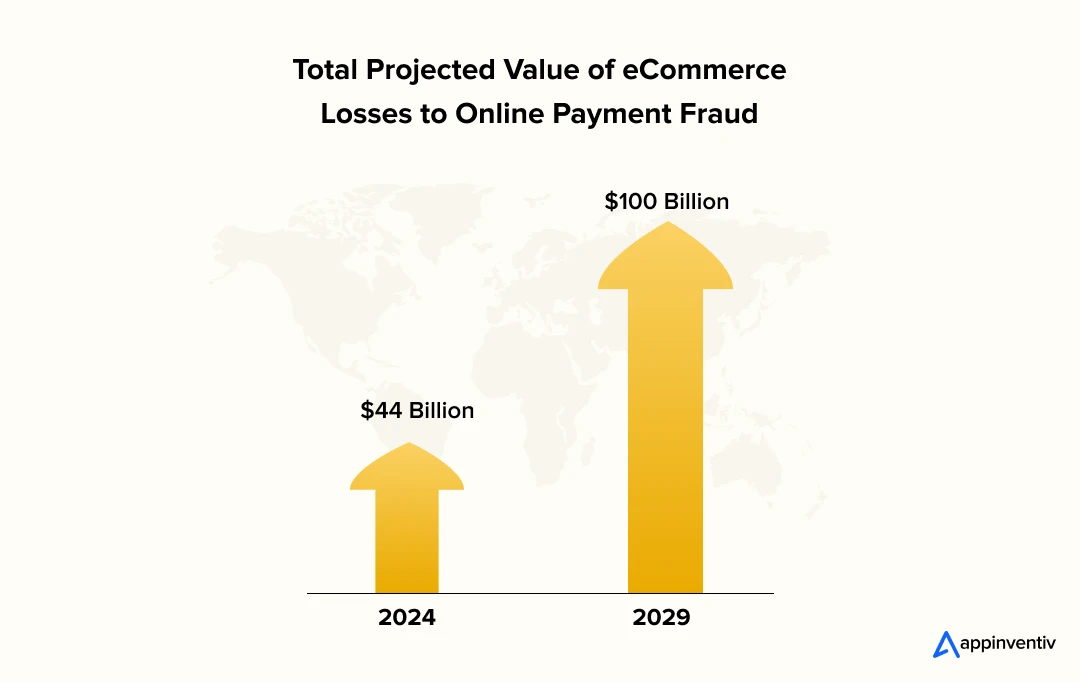
But AI-powered systems adapt constantly, learn new patterns, and keep improving against growing threats. Generative AI for sales systems analyzes transaction patterns, device fingerprints, behavioral biometrics, and even typing patterns to spot suspicious activity in real-time. They learn from every transaction and get smarter with each interaction.
The beauty is that legitimate customers rarely notice the security working in the background, while fraudulent transactions get flagged immediately.
Real World Example
PayPal uses AI-powered fraud detection systems to monitor transactions, identify potential risks, and prevent fraudulent activity in real-time. This AI approach enables PayPal to reduce fraud and present a secure online payment experience to its users.
Product Design and Innovation
Here’s where generative AI in business gets really interesting—using AI to actually create better products. Companies are analyzing customer feedback, market trends, and competitor products to identify exactly what customers want in new products.
This approach lets companies develop products based on actual customer needs instead of guessing. The result is higher success rates for new product launches and products that customers genuinely love.
Real World Example
Unilever created an interactive diagnostic tool for one of its haircare brands. Customers answer questions about their hair and scalp conditions, and the AI creates personalized profiles and product recommendations using dermatology knowledge.
Dynamic Pricing Optimization
Pricing used to be set-and-forget. Now it’s a constant optimization game.
AI-powered dynamic pricing considers dozens of variables: customer price sensitivity, inventory levels, seasonal demand, competitor pricing, weather patterns, and more.
The system continuously adjusts prices to optimize for different objectives—maximize revenue, clear inventory, or increase market share—while maintaining customer satisfaction.
Retailers using AI pricing typically see revenue increases while maintaining healthy profit margins.
Real World Example:
Uber uses ML and AI for its surge pricing model to dynamically adjust fares to match supply and demand in real-time. This approach ensures competitive pricing while maximizing profitability, providing customers with transparent, market-driven prices.
Scalable Customer Insights and Analytics
Traditional analytics required data analysts to interpret results and generate insights. Generative AI applications in eCommerce automatically generate executive summaries, identify trends, and suggest actionable strategies.
Instead of waiting weeks for analysis, decision-makers can access personalized reports with key insights and recommended actions.
This democratization of data insights helps make faster decisions at every level, from planning to daily operations.
Real World Example
Netflix uses Generative AI to understand customer preferences and optimize its content discovery feature.
Also Read: How to Create a Video Streaming App Like Netflix?
Reach out to us today to explore how AI can transform your operations.

How to Implement Generative AI Solutions in eCommerce Operations
Here’s the truth about implementing generative AI in eCommerce—most companies overthink it and end up paralyzed by all the possibilities. The smart approach? Start small and focused. Here is how you can ace the game of generative AI implementation in eCommerce.
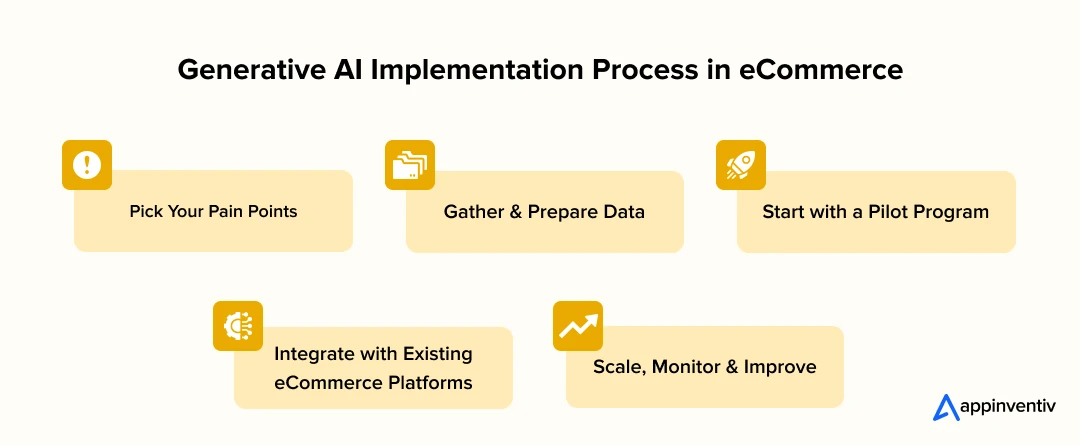
Phase 1: Pick Your Pain Points
Don’t try to revolutionize everything at once. Pick one area where AI can make an immediate impact:
- Customer service automation for common questions
- Product description generation for large catalogs
- Basic email personalization
- Simple inventory forecasting
The key is choosing something where you can measure results quickly and clearly.
Phase 2: Get Your Data House in Order
AI is only as good as your data. Before implementing anything, make sure your customer data, product information, and transaction records are clean and organized.
This isn’t glamorous work, but it’s absolutely critical. Garbage in, garbage out.
Phase 3: Start with a Pilot Program
Most successful companies run focused pilots rather than trying to boil the ocean. Test your chosen use case with a small segment of customers or products.
Monitor everything. Measure customer satisfaction, conversion rates, operational efficiency—whatever matters for your specific use case.
Phase 4: Integrate with Existing eCommerce Platforms
Ensure seamless integration of AI solutions with your current CRM, ERP, eCommerce platform, and marketing automation systems to avoid silos and maximize efficiency.
Phase 5: Scale What Works
Once you have proven ROI with your pilot, then you can start expanding. But only scale what’s actually working. Continuously track key performance indicators relevant to your AI initiatives to quantify the cost-effectiveness of generative AI in eCommerce.
Want to build an intelligent AI model from scratch for your eCommerce business? Then this blog is for you — How to Build an Intelligent AI Model: An Enterprise Guide
Cost of Implementing Generative AI in eCommerce
The cost of implementing generative AI in eCommerce varies wildly depending on your approach and scale.
What you are actually paying for:
- Technology Infrastructure: Cloud computing, API costs, software licenses
- Data Preparation: Cleaning and organizing your data
- Development and Integration: Custom development and connecting systems
- Training and Change Management: Getting your team up to speed
Organizations invested around $110 million on average for generative AI initiatives in 2024. But don’t let that number scare you—that’s enterprise-scale implementations. Small to medium businesses typically invest between $40,000 and $400,000 for initial AI implementations.
The Good News About Costs:
The cost-effectiveness of generative AI in eCommerce improves rapidly. API costs have dropped dramatically—some are half the price they were just a year ago.
Plus, companies typically see 3.7x returns on their AI investments. Most businesses see initial returns within 6-12 months (Source: amplifAI).
Related Article: AI Product Development Cost – A Comprehensive Guide
Future of Generative AI in eCommerce
The next few years are going to be wild for generative AI in retail and eCommerce. Here is what is coming next in the coming years:
Multimodal AI
This will become standard, allowing shoppers to interact using voice, text, and images interchangeably. Imagine describing a desired outfit verbally, uploading a mood board, and then seeing AI-generated visual interpretations, all leading to a seamless purchase.
Also Read: Top 10 Innovative Multimodal AI Applications and Use Cases
Agentic AI
AI agents can autonomously manage complex tasks. Imagine an AI that handles your entire inventory management, customer service, and marketing campaigns with minimal human oversight.
Voice Commerce Revolution
Natural conversations with AI assistants or AI-based voice commerce has now become the norm. Customers will discuss their preferences and purchases like they’re talking to a knowledgeable friend.
Predictive AI
AI will anticipate customer needs before they’re expressed. Your system will proactively suggest products based on life events, seasonal changes, and lifestyle patterns.
Sustainable Commerce
Environmental consciousness will drive AI applications that optimize for sustainability—reducing waste, optimizing delivery routes, and promoting circular economy practices.
What Makes Appinventiv Your Ideal Partner for Integrating Generative AI in eCommerce?
Embarking on the journey of generative AI implementation in eCommerce and reaping its rewards requires partnering with an experienced eCommerce app development company with a proven track record in delivering successful platforms for businesses of your kind.
This is where we come in. With a skilled team of 1600+ tech wizards and a portfolio of 3000+ successful projects, including retail and eCommerce, we are your trusted provider of generative AI services. Don’t believe us? Let’s have a quick glimpse at some of our successful eCommerce projects:
IKEA: We helped IKEA, the world’s largest home furnishings brand, build an intelligent ERP system.
The result?
- 7+ IKEA Stores Adopted the ERP System
- A smoother, more seamless digital shopping experience.
Adidas: We partnered with Adidas, a top sports merchandise brand, to build a high-performance eCommerce mobile app.
The result?
- 2 Million Downloads
- 500K New Users Acquired
6th Street: We collaborated with the popular fashion brand 6th Street on a cutting-edge eCommerce app. It’s a great example of our ability to deliver visually stunning and advanced platforms.
The result?
- 3+ Million Downloads on iOS
1+ Million Downloads on Android
Edamama: We developed a powerful, intuitive eCommerce app for Edamama. This platform helps new moms buy their basic essentials for children easily.
The result?
- $5 Million Funding Raised
- 100,000 Expectant and New Mothers Served
We took a big leap of faith with Appinventiv who helped us translate our vision into reality with the perfectly comprehensive Edamama eCommerce solution. We are counting to get Edamama to launch on time and within budget, while rolling out the next phase of the platform with AppInventiv

Our proven work experience with these leading brands exemplifies our capability to build successful, high-performance eCommerce platforms that deliver tangible results. We don’t just build apps; we build digital ecosystems that drive growth and meet the evolving needs of the modern consumer.
Ready to transform your business with the power of generative AI? Reach out to us today and let’s create something extraordinary together.
FAQs
Q. How does generative AI enhance eCommerce personalization?
A. Generative AI in eCommerce personalization goes way beyond showing your name in emails.
Modern AI creates unique shopping experiences for each visitor by analyzing individual behavior patterns, preferences, and context. It considers browsing history, purchase patterns, seasonal preferences, price sensitivity, and even shopping times.
Instead of generic product features, AI might highlight “waterproof” for outdoor enthusiasts or emphasize “quick delivery” for urgent shoppers. The system rewrites product descriptions, customizes marketing messages, and creates targeted offers that resonate with each customer’s specific needs.
Q. How is AI revolutionizing eCommerce product creation?
A. AI transforms product creation through several innovations. For instance:
- Automated Content Generation
- Visual Content Creation
- Market-Driven Development
Q. How to implement generative AI for eCommerce effectively?
A. Successful generative AI implementation in eCommerce follows a focused approach. Here is how it goes:
- Pick Your Pain Points
- Gather and Prepare Data
- Start with a Pilot Program
- Integrate with Existing eCommerce Platforms
- Scale, Monitor and Improve
To gain an in-depth understanding of these steps, please refer to the above blog.
Q. How is generative AI transforming eCommerce operations overall?
A. Generative AI is transforming eCommerce through its various applications, such as:
- Hyper-Personalized Customer Experiences
- Automated Product Descriptions and Content Generation
- Predictive Inventory and Supply Chain Optimization
- Intelligent Customer Support
- Hyper-Targeted Marketing
- Advanced Fraud Detection and Cybersecurity
- Product Design and Innovation
- Dynamic Pricing Optimization
- Scalable Customer Insights
- Immersive Shopping Experiences
- AI-Powered Visual Search
The transformation touches every aspect of eCommerce operations while delivering measurable results that justify investment.


- In just 2 mins you will get a response
- Your idea is 100% protected by our Non Disclosure Agreement.

Why Enterprises Need AI Strategy Consulting in Dubai
Key takeaways: Dubai is moving fast with AI adoption. But many enterprises still struggle to move beyond pilots and achieve real business results. AI strategy consulting gives leaders a clear plan. From use-case selection to data readiness, so enterprise AI initiatives stay on track and within budget. AI consulting in Dubai helps enterprises reduce compliance…

AI Governance Consulting: How to Build Guardrails, Observability, and Responsible AI Pipelines
Key takeaways: Enterprises can no longer rely on principles alone; AI governance must be built into pipelines, model workflows, and decision systems from day one. Strong guardrails across training, inference, retrieval, and agentic actions reduce risks like hallucinations, data leakage, and prompt injection. AI observability is central to governance, giving leaders real-time visibility into drift,…

How to Build a Custom Multilingual Chatbot? Features, Process, Costs
Key takeaways: Multilingual Chatbots Drive Revenue Growth: Companies see higher conversion rates when customers can interact in their native language, with nearly 75% of global customers preferring to buy from websites in their preferred language. Beyond Translation to Cultural Intelligence: Successful implementations require cultural adaptation, not just language translation. Systems must understand context, emotion, and…
